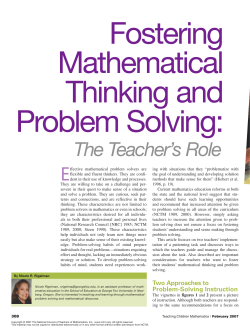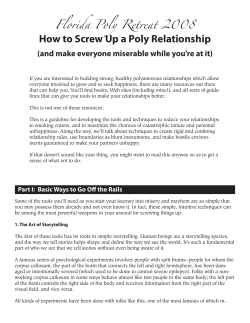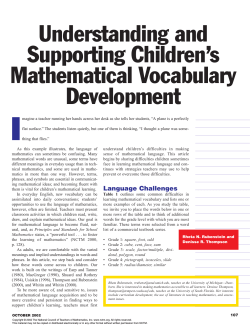
18.4 Errors and Percentage Change Introduction
Errors and Percentage Change ✏ ✒ ✑ 18.4 Introduction When one quantity is related to several others by a functional relationship it is possible to estimate the percentage change in it caused by given percentage changes in the other variables. If the input variables are measured and the measurements are in error, due to limits on the precision of measurement, then we can estimate the effect that these errors have on the output. ✛ ✘ Prerequisites Before starting this Block you should . . . ✚ Learning Outcomes ① understand the definition of partial derivatives and be able to find them (Block 18.1) Learning Style After completing this Block you should be able To achieve what is expected of you . . . to . . . ✓ calculate small errors in a function of more than one variable ✓ calculate approximate values for absolute, relative and percentage relative error ☞ allocate sufficient study time ☞ briefly revise the prerequisite material ☞ attempt every guided exercise and most of the other exercises ✙ 1. Approximations using partial derivatives Functions of two variables We saw in Block 16.5 how to expand a function of a single variable f (x) in a Taylor series: f (x) = f (x0 ) + (x − x0 )f (x0 ) + (x − x0 )2 f (x0 ) + . . . 2! This can be written in the alternative form (by replacing x − x0 by h): h2 f (x0 + h) = f (x0 ) + hf (x0 ) + f (x0 ) + . . . 2! This expansion can be generalised to functions of two or more variables. Indeed, for functions of two variables we find: f (x0 + h, y0 + k) f (x0 , y0 ) + hfx (x0 , y0 ) + kfy (x0 , y0 ) where, assuming h and k to be small, we have ignored higher-order terms involving powers of h and k. We define δf to be the change in f (x, y) resulting from small changes to x0 and y0 . Thus: δf = f (x0 + h, y0 + k) − f (x0 , y0 ) and so δf hfx (x0 , y0 ) + kfy (x0 , y0 ). Using the notation δx and δy instead of h and k for small increments in x and y respectively we may write δf δx.fx (x0 , y0 ) + δy.fy (x0 , y0 ) Finally, using the more common notation for partial derivatives, we write δf ∂f ∂f δx + δy. ∂x ∂y Informally, the term δf is referred to as the absolute error in f (x, y) resulting from errors δx, δy in the variables x and y respectively. Other measures of error are used. For example the relative error in a variable f is defined as δf and the percentage relative error is δf × 100. f f Key Point Measures of Error We define δf to be the change in f at (x0 , y0 ) resulting from small changes h, k to x0 and y0 respectively. Thus: δf = f (x0 + h, y0 + k) − f (x0 , y0 ). Absolute error in f is δf Relative error in f is Percentage relative error in f is δf f δf × 100 f We should note that to determine the error in any particular example we will need to know not only the actual values of δx and δy but also the values of x and y of interest. Engineering Mathematics: Open Learning Unit Level 1 18.4: Chap Title 2 Example Estimate the absolute error for the function f (x, y) = x2 + x3 y Solution ∂f = 2x + 3x2 y; ∂x ∂f ∂y = x3 . Then δf (2x + 3x2 y)δx + x3 δy Try each part of this exercise We seek the absolute error for f (x, y) = x2 y 2 + x + y. Obtain the absolute error at the point (−1, 2) if δx = 0.1 and δy = 0.025. Part (a) First find ∂f ∂x and ∂f ∂y Answer Part (b) Now obtain the absolute error Answer Part (c) Finally obtain the value of the absolute error at the point of interest. Answer Functions of three or more variables If f is a function of three or more variables x, y, u, v, . . . the error induced in f as a result of making small errors δx, δy, δu, δv . . . in x, y, u, v, . . . is found by a simple generalisation of the expression given above: δf ∂f ∂f ∂f ∂f δx + δy + δu + δv + . . . ∂x ∂y ∂u ∂v Example Suppose that the area of triangle ABC is to be calculated by measuring two sides and the included angle. Call the sides b and c and the angle A. Then the area S of the triangle is given by 1 S = bc sin A. 2 Now suppose that the side b is measured as 4.00 m, c as 3.00 m and A as 30o . Suppose also that the measurements of the sides could be in error by as much as ± 0.005m and of the angle by ± 0.01o . Calculate the likely error induced in S as a result of the errors in the sides and angle. 3 Engineering Mathematics: Open Learning Unit Level 1 18.4: Chap Title Solution Here S is a function of three variables b, c, A. We calculate S= Now ∂S ∂b = 12 c sin A, ∂S ∂c = 12 b sin A and 1 1 × 4 × 3 × = 3m2 . 2 2 ∂S ∂A = 12 bc cos A. Then ∂S ∂S ∂S δb + δc + δA ∂b ∂c ∂A 1 1 1 = c sin A δb + b sin A δc + bc cos A δA. 2 2 2 δS π Here δb = δc = 0.005 and δA = 180 × 0.01 (remember that A must be measured in radians). Substituting these values we see that the error in the calculated value of S is given by the approximation √ 1 3 1 1 1 1 π δS ×3× × 0.005 + ×4× × 0.005 + ×4×3× × 0.01 2 2 2 2 2 2 180 0.0097 m2 Hence the estimated value of S is in error by about ± 0.01m2 Try each part of this exercise The function f (x, y) = x2 + y 2 + xy is given. Estimate the absolute error in f at the point x = 2, y = 3 if errors ± 0.01 and ± 0.02 are made in x and y respectively. Part (a) First find ∂f ∂x and ∂f . ∂y Answer Part (b) If x has a measured value of 2 and y of 3 calculate the value of f (x, y). Answer Part (c) Now since the error in the measured value of x is ± 0.01 and in y is ± 0.02 we have; δx = 0.01, δy = 0.02. Write down an approximation to δf . Answer Part (d) Calculate the error in f , namely δf Answer Engineering Mathematics: Open Learning Unit Level 1 18.4: Chap Title 4 2. Percentage relative error Other measures or error can be obtained from a knowledge of the expression for the absolute error. Suppose that f (x, y) = x2 + y 2 + xy then δf ∂f ∂f δx + δy ∂x ∂y = (2x + y)δx + (2y + x)δy As mentioned earlier the relative error in f is Hence δf f δf f and the percentage relative error is 1 ∂f 1 ∂f δx + δy f ∂x f ∂y = (2y + x) (2x + y) δx + δy x2 + y 2 + xy x2 + y 2 + xy δf f × 100 %. The actual value of the relative error can be obtained once the errors of the independent variables are known and the values of x and y at the point of interest. In the special case where the function is a combination of powers of the input variables then we have a short cut to finding the relative error in the value of the function. For example if 2 4 f (x, y, u) = xuy3 then ∂f 2xy 4 = 3 , ∂x u Hence δf ∂f 4x2 y 3 , = ∂y u3 ∂f 3x2 y 4 =− 4 ∂u u 2xy 4 4x2 y 3 3x2 y 4 δx + δy − δu u3 u3 u4 Finally, δf u3 4x2 y 3 u3 3x2 y 4 u3 2xy 4 × δy − × δu 3 × 2 4 δx + f u xy u3 x2 y 4 u4 x2 y 4 Cancelling down the fractions, δf δx δy δu 2 +4 −3 f x y u (∗) so that rel. error in f 2(rel. error in x)+ 4(rel. error in y) − 3(rel. error in u). Note that if we write f (x, y, u) = x2 y 4 u−3 we see that the coefficients of the relative errors on the right-hand side of (∗) are the powers of the appropriate variable. To find the percentage relative error we simply multiply the relative error by 100. Try each part of this exercise 3 If f = xu2y and x, y, u are subject to percentage relative errors of 1, −1 and 2 respectively find the approximate percentage relative error in f . 5 Engineering Mathematics: Open Learning Unit Level 1 18.4: Chap Title Part (a) First find ∂f , ∂f ∂x ∂y and ∂f . ∂u Answer Part (b) Now write down an expression for δf Answer Part (c) Hence write down an expression for the percentage relative error in f Answer More exercises for you to try 1. The sides of a right angled triangle enclosing the right angle are measured as 6m and 8m respectively. The maximum errors in each measurement are ± 0.1m. Find the maximum error in the calculated area. 2. In question 1, the angle opposite the 8m side is calculated from tan θ = 86 as 530 8 . Calculate the approximate maximum error in that angle. 3x find the maximum percentage error in v due to errors of 1% in x and 3. If v = y 3% in y. 1 E 4. If n = and L, E and d can be measured correct to 1%, how accurate is the 2L d calculated value of n? 5. The area of a segment of a circle which subtends an angle θ is given by A = 1 2 r (θ − sin θ). The radius r is measured with a maximum percentage error of 2 0.2% and θ is measured as 450 with a maximum error of 0.10 . Find the maximum percentage error in the calculated area. Answer Engineering Mathematics: Open Learning Unit Level 1 18.4: Chap Title 6 End of Block 18.4 7 Engineering Mathematics: Open Learning Unit Level 1 18.4: Chap Title ∂f ∂x = 2xy 2 + 1, ∂f ∂y = 2x2 y + 1 Back to the theory Engineering Mathematics: Open Learning Unit Level 1 18.4: Chap Title 8 δf (2xy 2 + 1)δx + (2x2 y + 1)δy Back to the theory 9 Engineering Mathematics: Open Learning Unit Level 1 18.4: Chap Title δf (2xy 2 + 1)δx + (2x2 y + 1)δy = (−7)(0.1) + (5)(0.025) = −0.575. The actual error is easily calculated so we can compare the two values. We find δf = f (x0 + δx, y0 + δy) − f (x0 , y0 ) = f (−0.9, 2.025) − f (−1, 2) = −0.5534937. We see that there is a reasonably close correspondence between the two values. Back to the theory Engineering Mathematics: Open Learning Unit Level 1 18.4: Chap Title 10 ∂f ∂x = 2x + y; ∂f ∂y = 2y + x. Back to the theory 11 Engineering Mathematics: Open Learning Unit Level 1 18.4: Chap Title f (2, 3) = 22 + 32 + 2 × 3 = 19. Back to the theory Engineering Mathematics: Open Learning Unit Level 1 18.4: Chap Title 12 δf (2x + y)δx + (2y + x)δy Back to the theory 13 Engineering Mathematics: Open Learning Unit Level 1 18.4: Chap Title δf (2 × 2 + 3) × 0.01 + (2 × 3 + 2) × 0.02 = 0.07 + 0.16 = 0.23. Hence we quote f = 19 ± 0.23. Back to the theory Engineering Mathematics: Open Learning Unit Level 1 18.4: Chap Title 14 ∂f ∂x = 3x2 y , u2 ∂f ∂y = x3 , u2 ∂f ∂u 3 = − 2xu3y . Back to the theory 15 Engineering Mathematics: Open Learning Unit Level 1 18.4: Chap Title δf 3x2 y δx u2 + x3 δy u2 − 2x3 y δu u3 Back to the theory Engineering Mathematics: Open Learning Unit Level 1 18.4: Chap Title 16 u2 u2 δf 3x2 y u2 x3 2x3 y × × × 100 δx × 100 + δy × 100 − δu × 100 f u2 x 3 y u2 x 3 y u3 x3 y 3 δy δu δx × 100 + × 100 − 2 × 100 x y u = (3(1) − 1 − 2(2)) = −2% Note that f = x3 yu−2 . Back to the theory 17 Engineering Mathematics: Open Learning Unit Level 1 18.4: Chap Title 1. 1 A = xy 2 δA ≈ ∂A ∂A δx + δy ∂x ∂y y x δA ≈ δx + δy 2 2 Maximum error = |yδx| + |xδy| = 0.7 sq m. 2. θ = tan−1 y x so δθ = ∂θ ∂θ y x δx + δy = − 2 δx + 2 δy 2 ∂x ∂y x +y x + y2 6 0 (0.1)| + | 62 +8 Maximum error in θ is | 62−8 2 (0.1)| = 0.014 rad. This is 0.8 . +82 3. Take logarithms of both sides: ln v = 1 1 1 ln 3 + ln x − ln y 2 2 2 δx Maximum percentage error in v = | 2x |+|− δy | 2y δx δx δy ≈ − v 2x 2y so = 12 % + 32 % = 2%. 4. Take logarithms of both sides: ln n = − ln 2 − ln L + 1 1 ln E − ln d 2 2 Maximum percentage error in n = | − 5. δL | L so δE + | 2E |+|− δn δL δE δd =− + − n L 2E 2d δd | 2d = 1% + 12 % + 12 % = 2%. δA 1 2δr 1 − cos θ so A = r2 (θ − sin θ) = + δθ 2 A r θ − sin θ 1 − √12 δA π = 2(0.2)% + π × 100% = (0.4 + 0.65)% = 1.05% 1 A − √2 1800 4 Back to the theory Engineering Mathematics: Open Learning Unit Level 1 18.4: Chap Title 18
© Copyright 2025





















